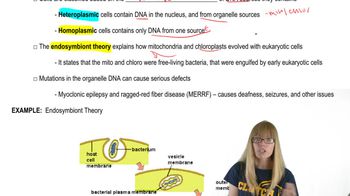The interphase nucleus is a highly structured organelle with chromosome territories, interchromatin compartments, and transcription factories. In cultured human cells, researchers have identified approximately 8000 transcription factories per cell, each containing an average of eight tightly associated RNAP II molecules actively transcribing RNA. If each RNAP II molecule is transcribing a different gene, how might such a transcription factory appear? Provide a simple diagram that shows eight different genes being transcribed in a transcription factory and include the promoters, structural genes, and nascent transcripts in your presentation.
Table of contents
- 1. Introduction to Genetics51m
- 2. Mendel's Laws of Inheritance3h 37m
- 3. Extensions to Mendelian Inheritance2h 41m
- 4. Genetic Mapping and Linkage2h 28m
- 5. Genetics of Bacteria and Viruses1h 21m
- 6. Chromosomal Variation1h 48m
- 7. DNA and Chromosome Structure56m
- 8. DNA Replication1h 10m
- 9. Mitosis and Meiosis1h 34m
- 10. Transcription1h 0m
- 11. Translation58m
- 12. Gene Regulation in Prokaryotes1h 19m
- 13. Gene Regulation in Eukaryotes44m
- 14. Genetic Control of Development44m
- 15. Genomes and Genomics1h 50m
- 16. Transposable Elements47m
- 17. Mutation, Repair, and Recombination1h 6m
- 18. Molecular Genetic Tools19m
- 19. Cancer Genetics29m
- 20. Quantitative Genetics1h 26m
- 21. Population Genetics50m
- 22. Evolutionary Genetics29m
10. Transcription
Transcription in Eukaryotes
Problem 25
Textbook Question
Elysia chlorotica is a sea slug that acquires chloroplasts by consuming an algal food source, Vaucheria litorea. The ingested chloroplasts are sequestered in the sea slug's digestive epithelium, where they actively photosynthesize for months after ingestion. In the algae, the algal nuclear genome encodes more than 90% but not all of the proteins required for chloroplast metabolism. Thus it is suspected that the sea slug actively maintains ingested chloroplasts, supplying them with photosynthetic proteins encoded in the sea slug genome. How would you determine whether the sea slug has acquired photosynthetic genes by horizontal gene transfer from its algal food source? Discuss the steps required for heritable endosymbiosis to eventuate, and their plausibility.
 Verified step by step guidance
Verified step by step guidance1
Step 1: Begin by isolating and sequencing the genome of Elysia chlorotica. This will allow you to identify all the genes present in the sea slug's genome. Use high-throughput sequencing technologies to ensure comprehensive coverage of the genome.
Step 2: Compare the sea slug's genome to the genome of its algal food source, Vaucheria litorea. Specifically, look for genes related to photosynthesis in the sea slug's genome that are homologous to those found in the algae. Use bioinformatics tools to identify homologous sequences and assess their similarity.
Step 3: Determine whether the identified photosynthetic genes in the sea slug's genome are functional. This can be done by analyzing their expression using techniques such as reverse transcription PCR (RT-PCR) or RNA sequencing to confirm that these genes are transcribed into mRNA.
Step 4: Investigate whether the proteins encoded by these genes are synthesized and functional in the sea slug. Use proteomics approaches, such as mass spectrometry, to detect the presence of photosynthetic proteins in the sea slug's tissues. Additionally, confirm their localization to the chloroplasts using immunofluorescence microscopy or other localization techniques.
Step 5: Discuss the plausibility of heritable endosymbiosis. For heritable endosymbiosis to occur, the photosynthetic genes must be stably integrated into the sea slug's germline genome and passed on to offspring. Evaluate whether there is evidence of vertical transmission of these genes and whether the chloroplasts themselves are inherited by the next generation. Consider the evolutionary and ecological implications of such a relationship.
 Verified video answer for a similar problem:
Verified video answer for a similar problem:This video solution was recommended by our tutors as helpful for the problem above
Video duration:
3mPlay a video:
Was this helpful?
Key Concepts
Here are the essential concepts you must grasp in order to answer the question correctly.
Horizontal Gene Transfer (HGT)
Horizontal Gene Transfer is the process by which an organism incorporates genetic material from another organism without being its offspring. This can occur through various mechanisms, such as transformation, transduction, or conjugation. In the context of Elysia chlorotica, HGT would involve the transfer of photosynthetic genes from the algal genome to the sea slug's genome, enabling it to produce proteins necessary for maintaining the chloroplasts.
Recommended video:
Guided course

Mapping Genes
Endosymbiosis
Endosymbiosis is a symbiotic relationship where one organism lives inside the cells of another. This concept is crucial for understanding how Elysia chlorotica retains functional chloroplasts from algae. For endosymbiosis to be heritable, the endosymbiont's genetic material must be integrated into the host's genome, allowing for the transfer of traits across generations, which raises questions about the mechanisms and evolutionary advantages of such integration.
Recommended video:
Guided course

Organelle DNA Characteristics
Gene Expression and Protein Synthesis
Gene expression is the process by which information from a gene is used to synthesize functional gene products, typically proteins. In Elysia chlorotica, the ability to maintain and utilize chloroplasts depends on the expression of photosynthetic genes. Understanding how the sea slug regulates the expression of these genes, potentially acquired through HGT, is essential for determining the mechanisms that allow it to sustain photosynthesis and the implications for its evolutionary biology.
Recommended video:
Guided course

Proteins

 9:16m
9:16mWatch next
Master Eukaryotic Transcription with a bite sized video explanation from Kylia
Start learningRelated Videos
Related Practice
Textbook Question
387
views
